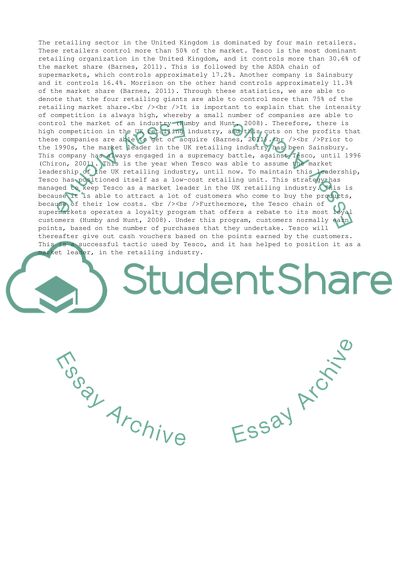Cite this document
(An Evaluation of the Effectiveness of Marketing Mix of the Tesco Case Study Example | Topics and Well Written Essays - 1500 words, n.d.)
An Evaluation of the Effectiveness of Marketing Mix of the Tesco Case Study Example | Topics and Well Written Essays - 1500 words. https://studentshare.org/business/1855331-evaluate-the-effectiveness-of-the-marketing-mix-of-one-of-the-key-retail-players-in-the-uk-supermarket-industry
An Evaluation of the Effectiveness of Marketing Mix of the Tesco Case Study Example | Topics and Well Written Essays - 1500 words. https://studentshare.org/business/1855331-evaluate-the-effectiveness-of-the-marketing-mix-of-one-of-the-key-retail-players-in-the-uk-supermarket-industry
(An Evaluation of the Effectiveness of Marketing Mix of the Tesco Case Study Example | Topics and Well Written Essays - 1500 Words)
An Evaluation of the Effectiveness of Marketing Mix of the Tesco Case Study Example | Topics and Well Written Essays - 1500 Words. https://studentshare.org/business/1855331-evaluate-the-effectiveness-of-the-marketing-mix-of-one-of-the-key-retail-players-in-the-uk-supermarket-industry.
An Evaluation of the Effectiveness of Marketing Mix of the Tesco Case Study Example | Topics and Well Written Essays - 1500 Words. https://studentshare.org/business/1855331-evaluate-the-effectiveness-of-the-marketing-mix-of-one-of-the-key-retail-players-in-the-uk-supermarket-industry.
“An Evaluation of the Effectiveness of Marketing Mix of the Tesco Case Study Example | Topics and Well Written Essays - 1500 Words”. https://studentshare.org/business/1855331-evaluate-the-effectiveness-of-the-marketing-mix-of-one-of-the-key-retail-players-in-the-uk-supermarket-industry.


